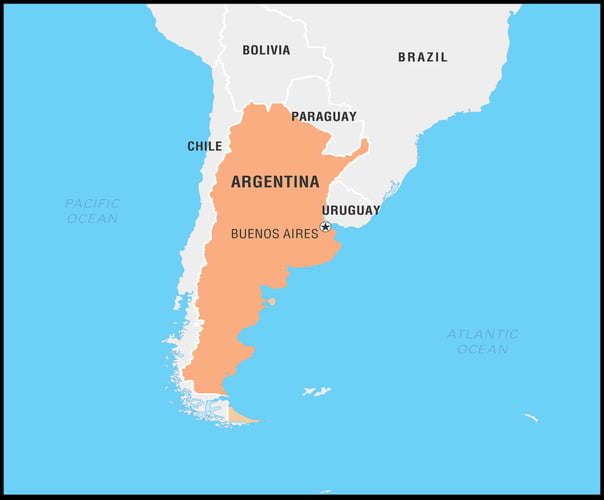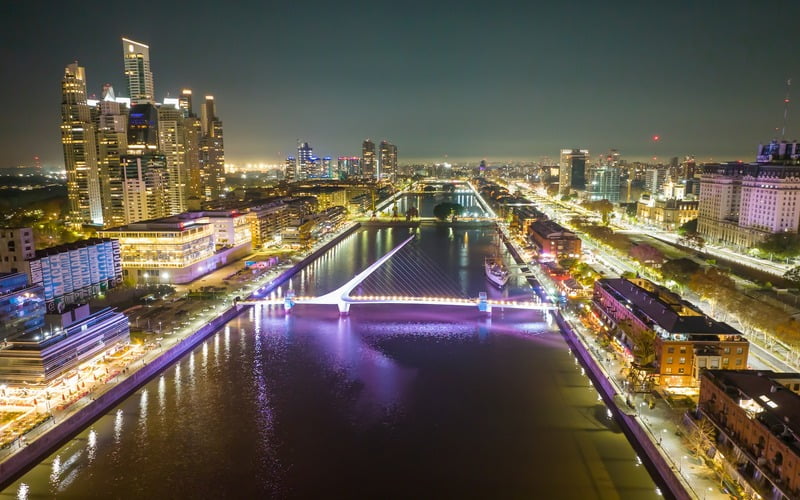As South America’s crown gem, Argentina entices visitors with its diverse cultural landscape, breathtaking landscapes, and lively traditions. As we go into the Top 10 Facts about Argentina we take an in-depth trip into the very spirit of this enchanting country. Argentina provides a fascinating/ variety of experiences, from the pulsating tango of Buenos Aires to the awe-inspiring splendor of Iguazu Falls and the wild beauty of Patagonia. We explore the mysterious past by looking at the ancient rock art of the Cave of the Hands, and we meet the legendary monster Nahuelito, who is claimed to live in the depths of Lake Nahuel Huapi.
We go to Tierra del Fuego, the southernmost point on Earth, and see the “ghost town” of Villa Epecuén rise from decades of obscurity. We also marvel at how the tango’s impassioned songs have spread beyond the bounds of Earth, and visit the thriving wine paradise of Mendoza, where the vineyards grow against the background of the Andes. Embark on a journey of a lifetime as we reveal the 10 most amazing and memorable features that make Argentina the crown jewel of the Southern Hemisphere.
Land Area: 2,780,400 km2
Official language: Spanish
Currency: Argentine Peso
Population: 45,787,845 (2023)
Capital: Buenos Aires
Table of Contents
Facts about Argentina’s History and Geography
History of Argentina
- For thousands of years prior to European colonization, indigenous peoples including the Diaguita and Guarani lived in this region.
- Although Juan Díaz de Solís, a Spanish adventurer, arrived at the Ro de la Plata in 1516, it wasn’t until 1536 that Pedro de Mendoza established the first permanent place there (now known as Buenos Aires).
- Instability and the abandonment of certain early colonies resulted from the area’s many confrontations with indigenous populations and other European powers.
- Buenos Aires was an important hub for Spanish colonization and commerce in this region throughout the 18th century.
- The Argentine War of Independence from Spain began in 1810 with the May Revolution in Buenos Aires and ended under the leadership of José de San Martín and Simón Bolívar in 1818.
- As a result of the independence and the founding of the Argentine Confederation and unification under President Domingo Faustino Sarmiento, Argentina experienced internal disputes and regional differences.
- Large numbers of people, especially from Europe, immigrated to Argentina in the last decades of the 19th century, enriching the country’s varied cultural heritage.
- The agricultural and export-driven expansion which the country enjoyed in the early 20th century resulted in it becoming one of the richest countries in the world.
- Throughout the 20th century, Argentina’s history was characterized by political instability, including military coups.
- In 1983, the nation started its transition back to democratic governance, which ultimately resulted in the formation of a constitutional republic; nonetheless, the country has faced and continues to face economic and political issues in more recent times.
Geographical Facts of Argentina

- Argentina is a country that can be found in South America and occupies the southeastern part of the continent.
- In terms of total land area, it is the 8th largest country in the world as well as the second largest in South America.
- Argentina is surrounded by Chile to the west, Bolivia and Paraguay to the north, Brazil and the Atlantic Ocean to the northeast, and Uruguay to the east.
- The Andes mountains form the western boundary, while the center Pampas plains and the southern Patagonia plateau add to the country’s rich diversity of geography.
- Mount Aconcagua in Argentina is the tallest mountain in both the Southern and Western Hemispheres with an elevation of 6,960.8 meters (22,837 ft).
- The length of the country’s coastline along the South Atlantic Ocean is 4,989 kilometers, which is approximately 3,100 miles.
- The Paraná, Uruguay, and Paraguay rivers are just a few of the many large rivers that flow through Argentina and help to replenish the country’s water supply.
- The Iguazu Falls are one of the most beautiful waterfalls in the world, They are in the northeastern part of the country and act as a natural border between Argentina and Brazil.
- Tierra del Fuego is an island in southern Argentina that is sometimes referred to as the “End of the World,” and its capital city Ushuaia is geographically the southernmost inhabited city on Earth.
- Argentina’s different ecosystems and animal habitats are made possible by the country’s vast diversity of temperatures, which span from subtropical in the north to subpolar in the deep south.
The Top 10 most interesting facts about Argentina are listed below.
01. Argentina has both the Southern Hemisphere’s highest and lowest levels.

Argentina, a nation of extraordinary geographical diversity, proudly claims the distinctions of having both of the Southern Hemisphere’s highest and lowest points. Mount Aconcagua is the highest peak in the Andes, standing at an astounding 6,960.8 meters (22,837 ft) above sea level. Located in the province of Mendoza, this spectacular mountain is not only Argentina’s highest point but also the highest summit outside of Asia. As such, it has the privilege of being the highest point in both the Southern and Western Hemispheres.
In contrast, the Santa Cruz province near Argentina’s southernmost tip is home to the immense salty depression of Laguna del Carbón, which sinks to a dizzying depth of 105 meters (344 ft) below sea level. The contrast between this natural marvel and the majesty of Mount Aconcagua is mesmerizing. This location is officially the lowest point in the Southern Hemisphere. This singularity cements Argentina’s reputation as a country of extremes, where towering mountains and deep depressions coexist, encouraging adventurers and explorers to view the amazing variety of landscapes that beautify this wonderful nation.
02. Argentina is The Land of Silver!

Argentina, sometimes known as “The Land of Silver,” is a historically significant nation whose landscapes were changed by the appeal of precious metals. The name “Argentina” comes from the Latin word “Argentum,” which means “silver,” attesting to the rich veins of this precious metal that drew the attention of early Spanish explorers. The Viceroyalty of the Ro de la Plata, which included modern-day Argentina and its neighbors, was established during the colonial period when rumors of enormous silver resources in the Andes Mountains attracted adventurers seeking riches.
Although the legendary silver mines were never discovered, the name has stuck as a symbol of the country’s success and promise. Argentina’s prosperity now comes from its many other resources, lively culture, and beautiful scenery rather than its silver mine. Argentina, known as “The Land of Silver,” celebrates its historical history while shining brilliantly with a rich tapestry of customs, natural beauties, and a vibrant attitude that continues to attract people throughout the globe.
03. Land of Multiple UNESCO World Heritage Sites

Argentina’s many UNESCO World Heritage Sites testify to the country’s rich history and unique landscape. Throughout the length and width of this multifaceted country are several sites of high universal importance that have been identified and are being protected by UNESCO. Visitors to Argentina are left in amazement by the country’s natural treasures, which range from the breathtaking Iguazu Falls, one of the world’s most magnificent waterfalls, to the majestic Los Glaciares National Park, where giant glaciers claw their way across rocky terrain.
The Jesuit Missions of the Guaranis, with their fascinating fusion of European and indigenous elements, are like stepping into another period for visitors. Ischigualasto and Talampaya are two national parks in Chile that are often referred to as the “Valley of the Moon” because of the lunar-like appearance of their geological formations. The ancient district of La Boca, with its colorful Caminito street, contributes to the country’s UNESCO beauty right in the middle of Buenos Aires’ buzzing city. Córdoba, with its ageless architecture and famous Jesuit Block, is a window into Argentina’s colonial past.
In addition, the gaucho culture is personified by the traditional estancias in the Pampas, while the Inca road network (Qhapaq ‘an) provides a historical link between modern-day Argentina and the country’s pre-Columbian past. Each of these UNESCO World Heritage Sites represents a fascinating period in Argentina’s history, and together they represent the country’s dedication to preserving its extraordinary legacy for future generations, making Argentina an even more alluring travel destination.
04. Patagonia: A Land of Myth and Adventure

Patagonia, “A Land of Myth and Adventure,” is a place where the wild spirit of nature blends with ancient myths and stories, inviting the brave adventurer to explore a world of breathtaking beauty and mysterious fascination. Geographically spanning the southernmost parts of Argentina and Chile, this vast and isolated territory is awe-inspiring for its varied and spectacular vistas. Ancient indigenous peoples made their imprint in Patagonia via elaborate rock art and traditions of mythological animals, both of which contribute to the region’s air of mystery.
Here, Mount Fitz Roy’s recognizable profile rises magnificently, while the impressive Perito Moreno Glacier moans and cracks, indicating the sheer might of the natural forces that form this area. From hiking through Torres del Paine National Park to sailing the Beagle Channel in the footsteps of early explorers, the world is ripe for the adventuring spirit. Those seeking a voyage of discovery are invited to Patagonia, a region where reality meets myth, where every step leads to encounters with the majesty of nature, and where the spirit of adventure sparks the soul.
05. The largest dinosaurs ever were discovered in Argentina
Argentina, a nation of infinite wonder, has produced a spectacular find that will reverberate through the annals of paleontological history: the world’s biggest dinosaurs. Patagonia, a region of Argentina rich in fossils, has revealed the remains of prehistoric giants that roamed the country’s immense wilderness. The awe-inspiring Argentinosaurus is one of them, and it’s a huge herbivore that could have been the biggest terrestrial animal ever. The absolute majesty of ancient existence is on display in the Argentinosaurus, which weighed in at an unbelievable amount and was over 100 feet in length, and its other giant relatives, such as the Giganotosaurus, another giant carnivore.
These astounding finds attest to the extensive paleontological history of Argentina, evoking a prehistoric era when gigantic creatures beyond our wildest imaginations roamed the earth. Argentina’s heritage as the home of the biggest dinosaurs is a shining example of the country’s dedication to scientific inquiry and discovery, and it is a monument to Argentina’s dedication to conserving and sharing the treasures of our planet’s ancient past.
06. It is home to a growing glacier

A developing glacier is a real example of Argentina’s appreciation for nature’s marvels. In Los Glaciares National Park, the Perito Moreno Glacier never ceases to amaze visitors with its breathtaking beauty and fascinating transformation. Among the world’s glaciers, Perito Moreno is one of the few that is expanding rather than shrinking. It’s unclear why this glacier is expanding when most others are shrinking throughout the globe. It is an amazing occurrence of nature’s tenacity that this glacier is one of the few that is actually advancing, going against the general trend of glacial retreat throughout the planet.
Its frozen surface area is in excess of 250 square kilometers, and its towering walls are as tall as a 24-story structure, making for a breathtaking scene of crystal-clear blue ice and crashing icefalls. Visitors watch in astonishment as massive sections of the glacier break off and fall into Lake Argentino, inspiring feelings of awe and humility. The Perito Moreno Glacier in Argentina provides visitors with a once-in-a-lifetime opportunity to experience the majesty of a growing glacier amidst the breathtaking landscapes of Patagonia, serving as a powerful symbol of the Earth’s delicate balance and the urgent need to preserve these natural marvels for future generations.
07. Buenos Aires: The “Paris of South America”

Buenos Aires, South America’s cosmopolitan jewel, is so stylish and refined that it’s sometimes called “the Paris of South America.” Visitors are captivated by the city’s intriguing combination of European elegance and Latin American vivacity, which is evident in its wide, tree-lined boulevards, beautiful buildings, and lively cultural scene. When taking a leisurely stroll through the streets of Buenos Aires, it’s impossible not to be captivated by the city’s ancient architecture, the entrancing tango performances in the city’s winding alleys, and the scent of freshly made coffee wafting from the city’s quaint cafés.
All who visit Buenos Aires are forever changed by the city’s unique charm, from the centrally located Obelisco to the bohemian neighborhood of La Boca, where colorful buildings of every color contribute to the city’s appeal. The city’s cultural landscape, which celebrates art, literature, and theatre, flourishes in historic venues like Teatro Colon, while the passionate spirit of football pulses in the stadiums where the sport is revered. The “Paris of South America,” Buenos Aires, is a city of contrasts, where old-world beauty meets modern vitality, inviting visitors to experience a mesmerizing combination of European finesse and Latin American passion.
08. The Southernmost City in the World: Ushuaia

Ushuaia, Argentina, is the southernmost city in the world. It is situated in the wilds of Patagonia and marks the end of the earth, where the limits of civilization appear to vanish into the vastness of Antarctica. This picturesque city, located on the Beagle Channel’s southern coasts, proudly embraces a character of its own, one that was forged by its rocky setting and rich nautical heritage. Ushuaia is the jumping-off point for explorations into Tierra del Fuego National Park, a snowy, glacier-covered area that is a paradise for outdoor enthusiasts.
While exploring the city’s bright alleys, visitors may learn about the history of the local Yaghan people and the explorations of famous names like Charles Darwin who ventured into these uncharted seas. Ushuaia’s voyages to Antarctica entice adventurers with the promise of unexplored regions and close encounters with amazing animals. The city of Ushuaia, located in Argentina, is the southernmost in the globe. Its name, which means “end of the world,” evokes the adventurous spirit of those who would come to this remote location to see the pristine beauty of nature.
09. Third-Longest Street in the World: Avenida Rivadavia

Avenida Rivadavia is a monument to the beauty and vitality of Buenos Aires, the capital of Argentina, and it winds like an infinite ribbon across the city’s center. This famous avenue, which runs over 29 kilometers (18 miles) from east to west, is sometimes referred to as “the world’s longest street” due to its incredible length. It passes through a large number of neighborhoods and links the city’s busy downtown. The variety of the city is on full display along the busy Avenida Rivadavia, a central artery that connects the city’s economic and residential hubs.
The vibrant stores, restaurants, theatres, and parks along this street attract residents and tourists alike to come and experience all that it has to offer. By just strolling along its broad sidewalks, one may feel the pulse of Buenos Aires and experience the city’s cultural and historical abundance firsthand. The longevity of Avenida Rivadavia in Buenos Aires is not only a reflection of the dynamic nature of the city but also a unifying symbol that links the city’s many diverse neighborhoods in a never-ending celebration of life and culture.
10. Football Passion

Argentines see their national obsession with football as much more than just a game. All throughout Argentina, from the heart of Buenos Aires to the furthest reaches of the countryside, you can hear the roaring of stadiums and the fervent cries of devoted supporters, bringing the whole nation together in a shared passion for the beautiful game. There is a deep and abiding feeling of national pride and identity among Argentinians, and football is the catalyst for this. The great players, from Diego Maradona to Lionel Messi, have become almost mythological figures, cherished as heroes by their own nations and trusted with the aspirations of countless fans across the globe.
When the stakes are great, football games become more than just contests; they’re massive spectacles where the line between win and failure blurs with every breath. Football is more than a game to the people of Argentina; it is a way of life, a source of pleasure, and an expression of their passion, devotion, and unbreakable spirit. This will ensure that the fiery flame of football’s enchantment continues to burn brightly in the heart of the country for as long as there is football.
Argentina has won the FIFA World Cup three times.
The 2022 FIFA World Cup was held in Qatar, and after an exciting campaign, Argentina was crowned the winner once again. Messi, the world’s greatest football genius, was the star as Argentina won the championship on penalties against France. Messi is the first player in World Cup history to score in every round, and he finished the tournament with two goals in the final match. He became the first player to win the Golden Ball twice after helping Argentina win the world cup.
Some Other Interesting Facts about Argentina

- Gastronomy Delights: Asado and Mate: Asado and Mate are two of Argentina’s most famous culinary specialties. Asado is a beloved BBQ tradition when friends and family gather to enjoy delicious meats seasoned with smoke. In the same way, a cup of warm Mate, a traditional herbal tea, shared between friends and family using a metal straw is a great way to bring people together. These delicious dishes are representative of the joy of life and the strong social bonds that unite the Argentine people.
- The Birthplace of Che Guevara: One of the most well-known revolutionaries of the 20th century was born in the house now known as “The Birthplace of Che Guevara.” Ernesto “Che” Guevara was born on June 14, 1928, in Rosario, Argentina; the home where he was born is now a museum where tourists may learn about his childhood. The Birthplace of Che Guevara is a powerful emblem of the revolutionary ideals and global influence of this pivotal person in Cuban history and the international fight for social justice.
- The Inventor of Fingerprinting: In the late 19th century, Argentine police officer Juan Vucetich developed the groundbreaking technique of fingerprinting as a means of identifying criminals. His major contributions to forensic science have had far-reaching effects on police work all across the globe.
- Invented Radio Broadcasting: As the country that pioneered radio transmission, Argentina has an important position in the annals of communication. Engineer Enrique Telémaco Susini had the foresight to transmit the first public radio program in 1920, and he changed the face of international communication in the process.
- Gaucho Culture and Estancias: Argentina’s rural identity revolves around the surviving heritage of expert horsemen and their nomadic way of life, which is celebrated via Gaucho Culture and Estancias. These classic ranches, known as estancias, are a great way to experience authentic Argentine hospitality and culture while also getting a glimpse into the country’s rich history. Gaucho Culture and Estancias give a genuine glimpse into rural Argentinean life, embodying the country’s spirited independence and freedom.
- Valdés Peninsula: A Marine Paradise: The Valdés Peninsula’s spectacular coastline scenery and rich marine life have earned it a place on the UNESCO World Heritage List. This marine sanctuary, which is home to sea lions, penguins, and southern right whales, provides a once-in-a-lifetime opportunity to see the marvels of nature.
- Mendoza’s Underground City: The streets of Mendoza hide a mystical subterranean metropolis connected by a labyrinth of tunnels and caverns, steeped in legend and history. The mysteries of this underground world are begging to be discovered by intrepid explorers.
- El Pato is the National Sport of Argentina: El Pato, a hybrid of polo and basketball played on horseback, is the official national sport of Argentina. It has deep roots in the country’s rural customs. This exciting equestrian activity represents the nation’s dedication to sports and its long history of horsemanship.
- There is a Law Against Naming a Child Messi: In a bizarre turn of events, Argentina outlawed the name “Messi” as a means of preserving the individuality of given names. Football hero Lionel Messi continues to serve as a symbol of national pride, and this law reflects the widespread affection and respect with which he is held.
Argentina, a nation of extraordinary variety and charm, has revealed a web of fascinating information that vividly depicts the country’s illustrious history and irrepressible spirit. Iguazu Falls, Perito Moreno Glacier, and the cultural riches of Buenos Aires, known as the “Paris of South America,” are just a few of the many reasons why Argentina is so appealing. Insights into its revolutionary and exploratory past may be gleaned by visiting landmarks like the Jesuit Missions and the Che Guevara Birthplace.
Travelers may enjoy the flavors of history and the warmth of Argentine hospitality while sampling the gourmet pleasures of Asado and Mate, and be captivated by the charisma of Gaucho Culture and Estancias, which show a strong link to the rural heart of the country. Ushuaia, the world’s southernmost city, and Valdés Peninsula, a marine wonderland, both provide out-of-this-world adventures. Meanwhile, Argentina has a rich history of invention, as seen by its contributions to fingerprinting and radio transmission.
Argentines value their rich history, represented by several World Heritage Sites while looking forward to an exciting future. With its captivating information, Argentina invites explorers, culture buffs, and nature lovers to set out on a once-in-a-lifetime journey to a land of myth and adventure, where passion and history blend harmoniously, leaving an indelible mark on the hearts of all who explore its enchanting landscapes and embrace its boundless spirit.



